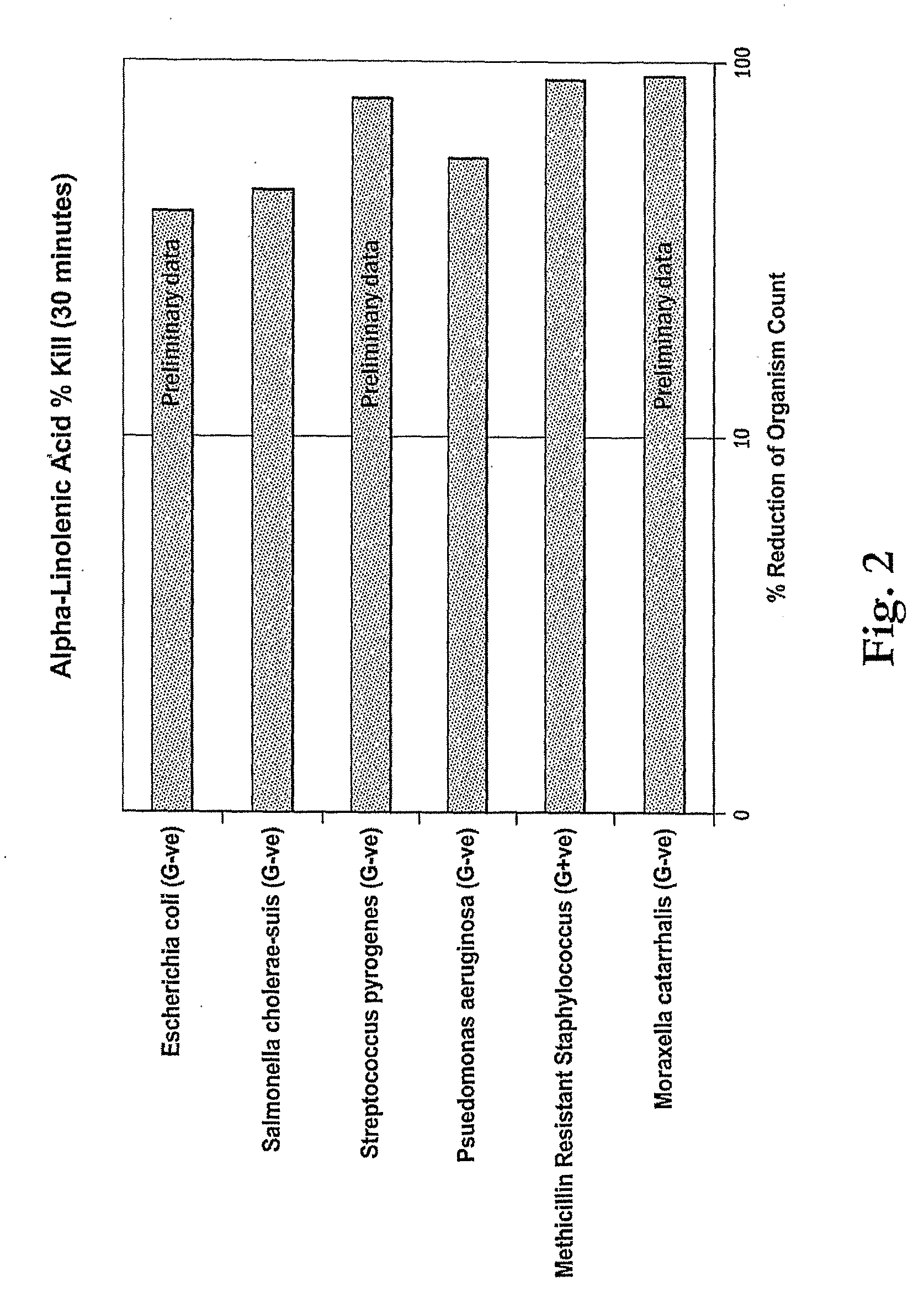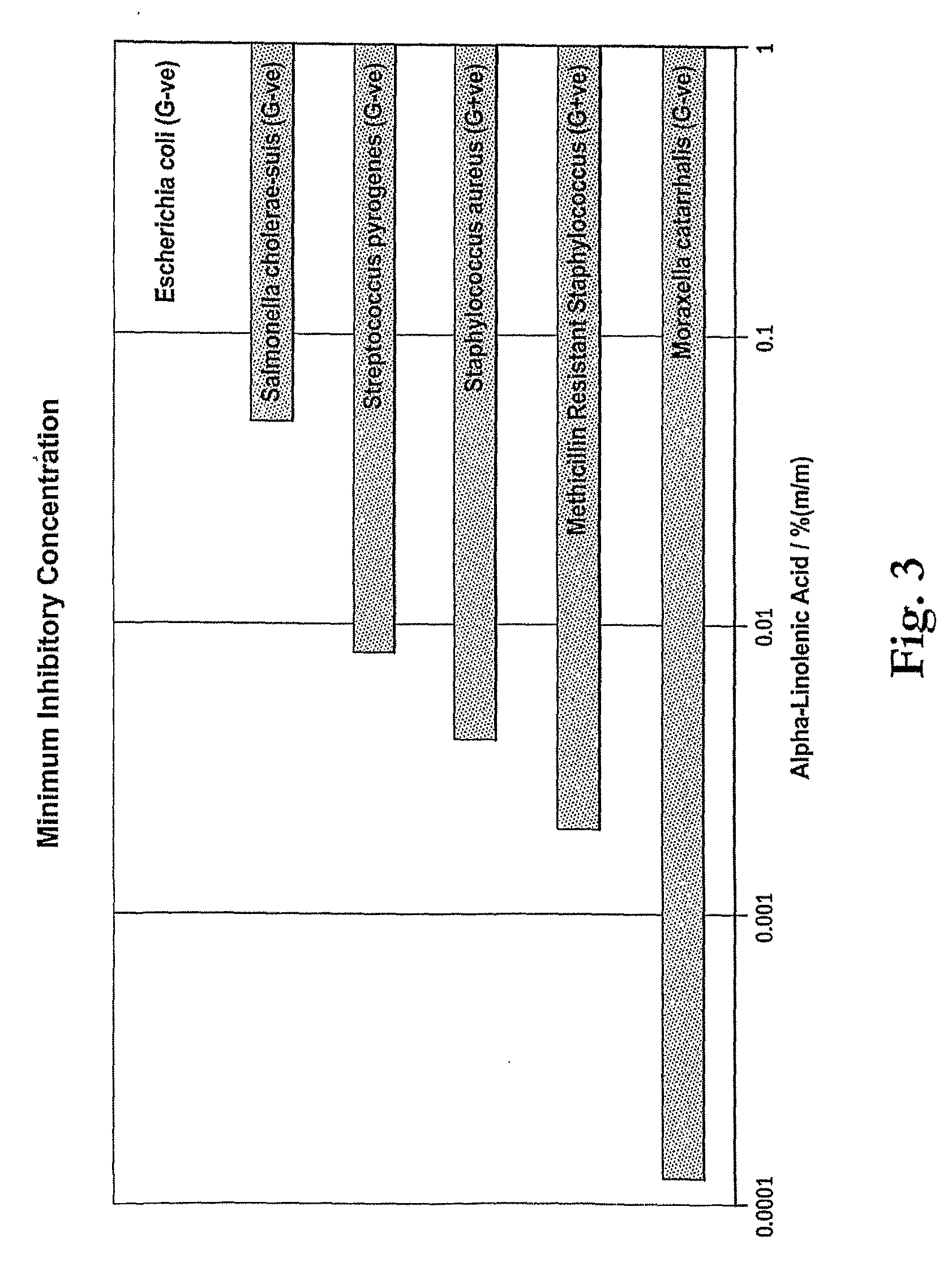Anti-Microbial Agent
a technology of anti-microbial agents and anti-bacterial agents, which is applied in the field of anti-microbial agents, can solve the problems of no longer effective antibiotic therapy against hospital staphylococci, increased risk of patients, and increased resistance of microorganisms to anti-microbial agents, and achieve the effects of preventing or inhibiting the growth of bacteria, preventing or inhibiting the growth of gram positive bacteria
- Summary
- Abstract
- Description
- Claims
- Application Information
AI Technical Summary
Benefits of technology
Problems solved by technology
Method used
Image
Examples
example 1
Minimum Inhibitory Concentration Test for α-Linolenic Acid
[0075]The following tests were conducted to determine the minimum concentration of α-linolenic acid required to inhibit growth of three strains of bacteria which are representative of microorganisms desired to be inhibited by antimicrobial compositions. The test results show that low levels corresponding to compositions having as little as 0.1%.
[0076]A sample of 90% α-linolenic acid was diluted in accordance with the following protocol to test the minimum effective concentration against the bacteria. The α-linolenic acid was diluted to the dilutions shown in Tables 2A to 2F using Tryptone Soya broth Sigma Aldrich. Each diluted sample was inoculated with approximately 106 test microorganisms of the class and incubated for 48 hours at 37° C. The test microorgansisms were S. aureus, S. cholerae, MRSA, E. coli, S. pyogenes and M. catarrhalis.
[0077]Uninoculated broth was included as a control.
[0078]Following the incubation period...
example 2
Compositions Comprising α-Linolenic Acid
[0080]Compositions comprising 1% and 2% α-linolenic acid were prepared with the following components:
1% Solution:%Material1α-linolenic acid, 90% purity, fromOptigen (South Australia)3Cetostearyl Alcohol5Sweet Almond Oil10Emulgade N1 10002Glycerol1Benzyl Alcohol1Cyclomethicone (DC 345)10SLES (TEXAPON N25)10Betaine (Empigen BS AU)1Linolenic Acid56Purified Water
2% Solution:%Material2α-linolenic acid, 90% purity, fromOptigen (South Australia)3Cetostearyl Alcohol5Sweet Almond Oil10Emulgade N1 10002Glycerol1Benzyl Alcohol1Cyclomethicone (DC 345)10SLES (TEXAPON N25)10Betaine (Empigen BS AU)1Linolenic Acid55Purified Water
example 3
Anti-Microbial Activity of Compositions Comprising α-Linolenic Acid
[0081]The 1% solution of Example 2 was subjected to testing to show that such solutions are effective in preventing growth of both Gram positive and Gram negative bacteria.
[0082]The biocidal effect of the 1% α-linolenic acid solution was tested against MRSA (Gram positive, facultative anaerobe), Salmonella cholerae (Gram negative, aerobe), and Pseudomonas aeruginosa (Gram negative, anaerobe) using a suspension test. The suspension test was performed according to the following procedure:[0083]1. The starting microorganism concentration was determined by standard plate count technique for each of a test microorganism culture comprising 1% α-linolenic acid and a control microorganism culture. The microorganism concentration of each culture was recorded as cfu / mL.[0084]2. At desired time points, a sample of each culture was removed and the microorganism concentration of each culture was determined by the standard plate c...
PUM
| Property | Measurement | Unit |
|---|---|---|
| polyunsaturated fatty acid | aaaaa | aaaaa |
| weight | aaaaa | aaaaa |
| concentration | aaaaa | aaaaa |
Abstract
Description
Claims
Application Information
 Login to View More
Login to View More - R&D
- Intellectual Property
- Life Sciences
- Materials
- Tech Scout
- Unparalleled Data Quality
- Higher Quality Content
- 60% Fewer Hallucinations
Browse by: Latest US Patents, China's latest patents, Technical Efficacy Thesaurus, Application Domain, Technology Topic, Popular Technical Reports.
© 2025 PatSnap. All rights reserved.Legal|Privacy policy|Modern Slavery Act Transparency Statement|Sitemap|About US| Contact US: help@patsnap.com



